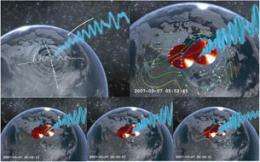Magnetic disturbances help predict the arrival of a space storm.
(PhysOrg.com) -- A team of researchers at the University of Alberta in Edmonton has broken new ground in outer space by pinpointing the impact epicentre of an Earthbound space storm as it crashes into the atmosphere and giving an advance warning that it's on the way.
The studies, using data from the NASA THEMIS mission, reveal that magnetic blast waves can be used to pinpoint and predict the location at the edge of space where space storms dissipate their energy. The technique can be considered as the seismology of space, the epicentre marking the location where the energy equivalent to 50 gigawatts of power, or the output of 10 of the world's largest power stations, is dumped into the atmosphere.
Physicists Jonathan Rae and Ian Mann are leading the U of A research team that has found the epicenter of impact. Their team is using ground stations spread across northern Canada and the five satellites of the THEMIS project to pick up magnetic disturbances as the storm crashes into the atmosphere. With information from the "space seismology" the researchers look for the eye of the storm, hundreds of thousands of kilometres above the Earth.
"We see the benevolent side of space storms in form of the northern lights," said Mann. "When electrically charged particles speed towards Earth and buffet the atmosphere, the result is often a dancing shimmering light over the polar region."
The U of A team has also determined that the magnetic tremors show that the space storm impact into the atmosphere has a unique epicentre. The eye of the storm is in deep space, far past the orbits of most communication satellites. Guided by the Earth's magnetic field, the magnetic tremors rocket through space towards the planet. These disturbances trigger magnetic sensors on the ground as they impact the atmosphere at the edge of space. The space storm's effects, and the most spectacular displays of the northern lights, follow a few minutes later. The Earth is protected from the most damaging direct effects of the radiation from these space storms by its atmosphere, but in space there is nowhere to hide. High-energy electrically charged particles released in space storms can disable spacecraft, interrupt radio communications and GPS navigation, and damage electric power grids.
Probing the eye of a space storm and recognizing the advance warning signs are crucial for researchers trying to understand space weather. Key questions about when and how space storms start are still challenging researchers on the THEMIS team. Like forecasters on Earth who predict severe weather, the University of Alberta researchers are now using these magneto-seismic techniques to investigate methods to forecast space storms.
Provided by University of Alberta (news : web)




















